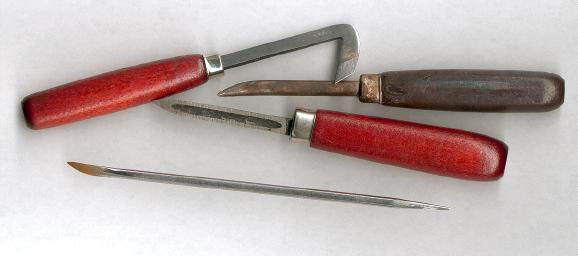Notes about Intaglio Prints, Etching, and Monotypes
Relating to Tessa Johnson's Prints
An intaglio print is an image printed from an etched metal plate. Often intaglio
prints are referred to as etchings. They are "Fine Art Prints."
Etching is the process of working a design into metal by the corrosive action of acids.
A printing plate is created through this etching process which will hold a design or image. The metal plate, usually copper, zinc, or soft steel, is coated with an acid resistant ground then engraved or carved . The exposed plate is placed in acid to create a texture. The plate is then coated with a thick oil based ink and wiped with a rag to remove the excess ink. The areas with texture hold the ink, the smooth areas are wiped clean. Each print is hand inked and wiped individually.
Aquatint is a variation of etching where rosin and acid are used to create a porous surface to create tonal areas. This is my favorite process.
Dry Point etching is a variation of etching where no acid is used .The design is created by scribing lines into metal plate (copper, zinc, soft steel, etc.) with hard steel - or diamond-point needles. A burr is formed along the scribed lines that holds the ink and creates the image. Drypoints are a great deal more delicate and hold up for a smaller edition than acid formed etching.
Most etchings are a combination of several etching techniques.
To print an etching, the metal etched and inked plate is place on the press bed face up, wet printmaking paper is placed over the plate, then a wool blanket called a felt is placed over the paper. Like a sandwich the three components are run through the etching press to create a print. The paper is then lifted off of the plate and the result is an Intaglio print or an etching.
Etchings are printed in editions. A limited edition or limited number of prints are made. After a number of printings, the plate looses the sharp image and begins to show wear. This is particularly noticable in Dry Points. I make 50 prints at the most and then strike the plate by carving an X over the face of the plate. This is the standard way for a printmaker to destroy his plates.
A Monotype or Monoprint is a print in an edition of one; a unique print. Actually it is a printed painting or printed drawing on a smooth etching plate that is then run through the etching press to transfer the image to paper. I use an oil paint or ink and print the image in the same manner in which an intaglio print is done.
Each print is numbered and signed. 11/40 is the 11th print done in an edition of 40 prints. An Artist Proof is a print made to test the plate and then for use as quality control in the edition. Sometimes they are sold and marked with an AP.
Etching is quite a toxic process. In the past 20 years many developments in the process have been made just that reason. Printmaking is an ever changing process. |
Tessa Johnson © all
rights reserved.
|

